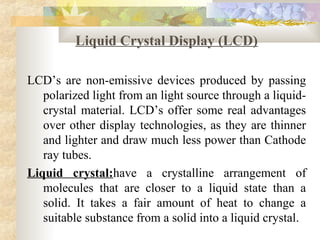
Lcd's
- 1. Liquid Crystal Display (LCD) LCD’s are non-emissive devices produced by passing polarized light from an light source through a liquid- crystal material. LCD’s offer some real advantages over other display technologies, as they are thinner and lighter and draw much less power than Cathode ray tubes. Liquid crystal:have a crystalline arrangement of molecules that are closer to a liquid state than a solid. It takes a fair amount of heat to change a suitable substance from a solid into a liquid crystal.
- 2. A particular sort of nematic liquid crystal, called twisted nematics, is naturally twisted & tends to keep the long axes of the rod- shaped molecules aligned are used. Applying an electric current to these liquid crystals will untwist them to varying degrees, depending on the current's voltage. Two glass plates, each containing a light polarizer at right angles to the other plate contains the liquid crystal material.
- 5. Rows of horizontal transparent conductor are built into one glass plate, & columns of vertical are put into other plate. Intersection of two defines a pixel position. Normally molecules are aligned in the “on state”. Polarized light passing to the material is twisted so that it will pass through the opposite polarizer. The light is reflected back to the viewer. Liquid crystal materials emit no light of their own.
- 6. To turn off the pixel, we apply a voltage to the two intersecting conductors to align the molecules so that the light is not twisted. This type of devices are known as passive- matrix LCD. Colors can be displayed by using diff materials at each screen position.
- 7. Another method for constructing LCD’s is to place a transistor at each pixel position, using thin –film transistor technology, which are used to control the voltage at pixel position locations & to prevent charge from gradually leaking out of the liquid-crystal cells. These device are called active-matrix displays.
